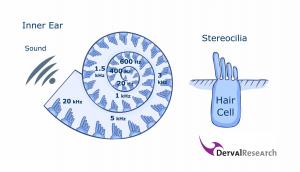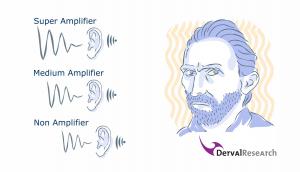Music preferences: people respond to specific frequencies
Research suggests music preferences come down to specific frequencies individuals respond to, and that these preferences are set in their inner ear.
The hearing profile and the music frequency, rather than the music genre, seems instrumental in predicting people's likes and dislikes.”
BERLIN, GERMANY, November 10, 2022 /EINPresswire.com/ -- Why is the same sound or music perceived as soothing by some and irritating by others? Explaining variations in the perception of sound and music would help design adapted acoustic experiences while limiting discomfort and audio fatigue. — Prof. Diana Derval, PhD, Chief Investigator, DervalResearch
DervalResearch studied the impact of hearing profiles on music preferences. Twenty-five thousand hair cells, located in the inner ear, help humans perceive sounds between 20Hz and 20kHz (Figure 1). Each stereocilia captures and amplifies a certain frequency. Hair cells and stereocilia generate their own noise when amplifying the sound. This noise is called otoacoustic emissions (OAEs) and can be objectively measured with a device.
The work just presented at the Audio Engineering Society 153rd Convention in New York in the paper “Hearing patterns, otoacoustic emissions, and music preferences” caught the interest of sound professionals, as music preferences could be set in the inner ear from birth, and linked to the frequency of the tune. Although researchers have been looking into music preferences and music genres, tempo, and music keys, the link between music frequencies and hearing patterns had been less investigated until now.
“The hearing profile and the music frequency, rather than the music genre, seems instrumental in predicting people's likes and dislikes.” highlights Dr. Diana Derval, Chief Investigator at DervalResearch, who led the research team that compared people's hearing pattern with their favorite tunes. Some subjects, called super-amplifiers, heard the same sound four times louder than others, which corresponds to a difference of 20 decibels (Figure 2).
People tended to prefer music tunes having a peak in a frequency that they amplify less. Dr. Derval explains: “Paradoxically, individuals who love high-pitch guitar solos, for instance, tend to hear these frequencies less well.” Subjects also tended to find irritating the tunes having a peak in a frequency that they amplify very well.
Although subjects with the same hearing profile declared listening to very different music genres, in the end the spectrograms of their favorite music tunes tended to have their peaks in the same frequency range. The research results might explain the variations in sound and music preferences and help brands adapt products and experiences in the field of consumer electronics, gaming, XR, and virtual worlds. Public transports and spaces might also improve citizens' well-being by designing more neutral, and better equalized, acoustic experiences.
The findings are detailed among other surprising sensory insights in Prof. Diana Derval’s latest book “The Right Sensory Mix: Decoding Customers’ Behavior and Preferences”, published by Springer Nature.
##
Prof. Diana Derval, PhD
DervalResearch
+372 602 7208
email us here
Visit us on social media:
Facebook
Twitter
LinkedIn


